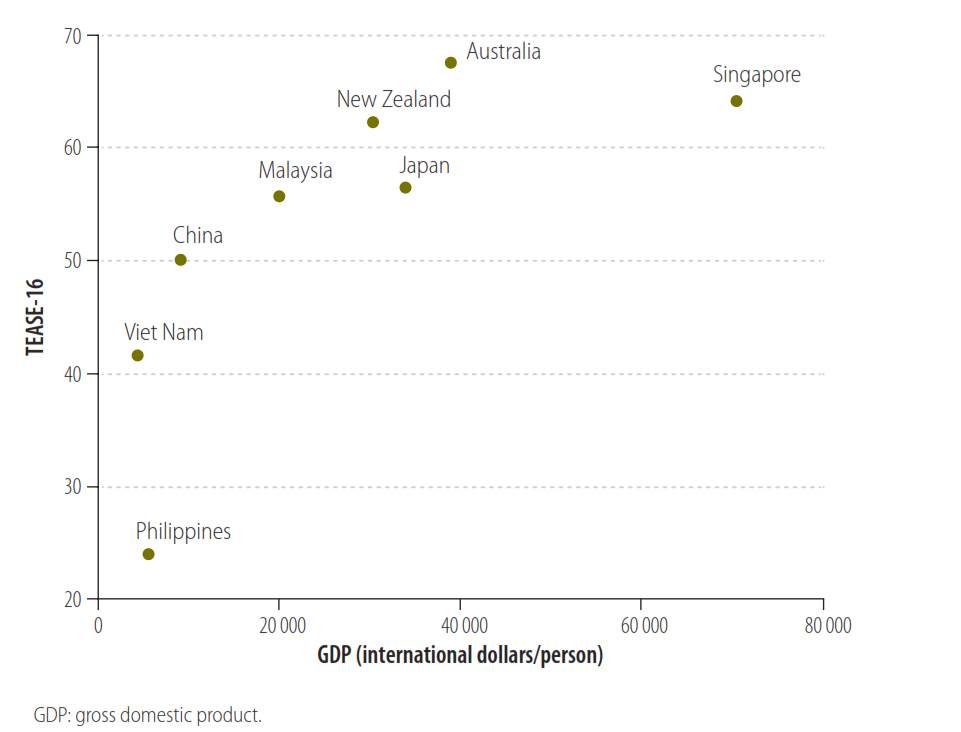Carragher et al.11. Carragher N, Byrnes J, Doran CM, Shakeshaft A. Developing an alcohol policy assessment toolkit: application in the western Pacific. Bull World Health Organ. 2014 Oct 1;92(10):726-33. http://dx.doi.org/10.2471/BLT.13.130708 PMID:25378726
http://dx.doi.org/10.2471/BLT.13.130708... describe the development and application of an alcohol policy score (TEASE-16) to nine study areas in the western Pacific. In their analysis they attempt to relate the policy score to average alcohol consumption for these areas. My analysis shows that their correction for income is not required, and that their use of division to correct for consumption needs justification, because it produces a consumption variable of litres per dollar.
In an attempt to analyse the cross-sectional data correctly, I obtained information on alcohol consumption for eight of the study regions from published WHO data for 2010,22. Global status report on alcohol 2014. Geneva: World Health Organization; 2014. which does not separate data for Hong Kong Special Administrative Region from the rest of China. I obtained gross domestic product (GDP) and population data for 2010 from published World Bank information.
I did a multiple regression analysis using methods described by Kronmal33. Kronmal RA. Spurious correlation and the fallacy of the ratio standard revisited. JR Stat Soc. 1993;156(3):379-92. http://dx.doi.org/10.2307/2983064
http://dx.doi.org/10.2307/2983064... to avoid the well-known problem of spurious correlation arising from the use of rates.44. Pearson K. Mathematical contributions to the theory of evolution. On a form of spurious correlation which may arise when indices are used in the measurement of organs. Proc R Soc Lond. 1896;60(1):489-98. http://dx.doi.org/10.1098/rspl.1896.0076
http://dx.doi.org/10.1098/rspl.1896.0076... The results show that alcohol consumption does not appear to be related to income (measured by GDP or GDP per-capita) or to TEASE-16 for the eight regions considered. However TEASE-16 is related to GDP, but not in a linear fashion.
In my regression model, I considered total alcohol consumption in each area as the response, with GDP, population and TEASE-16 score the predictors. Only population size was significantly associated with total alcohol consumption (Table 1), and examination of outliers show that this association arises because of the influence of China with its much larger population. Fitting of the submodels involving only population and TEASE-16 and only GDP and population did not alter this conclusion. Similarly, including total population aged over 15 as a predictor did not alter the conclusion.
Multiple regression results for alcohol consumption with predictors GDP, TEASE-16 and population
The relationship between TEASE-16 and GDP per capita is shown in Fig. 1. It can be seen that the relationship is not linear and I confirmed this by fitting a regression model with a quadratic term in GDP. Fitting a regression relationship as in Table 1, but including the square of GDP as a predictor once again, did not alter the conclusions. The inappropriate adjustment done by Carragher et al. for income is the source of the spurious relationship between TEASE-16 and consumption, since TEASE-16 is positively related to income and the consumption scores are divided by income, resulting in a negative relationship that is an artefact of the analysis.
Neither TEASE-16 score nor income, (measured by GDP), were significantly correlated with alcohol consumption across the eight areas in the year 2010. It seems unlikely that analysis of the original data used by Carragher et al.11. Carragher N, Byrnes J, Doran CM, Shakeshaft A. Developing an alcohol policy assessment toolkit: application in the western Pacific. Bull World Health Organ. 2014 Oct 1;92(10):726-33. http://dx.doi.org/10.2471/BLT.13.130708 PMID:25378726
http://dx.doi.org/10.2471/BLT.13.130708... would alter this conclusion (if so, it would raise concerns related to data quality), but I would be happy to undertake such analysis if the data were made available.
References
- 1Carragher N, Byrnes J, Doran CM, Shakeshaft A. Developing an alcohol policy assessment toolkit: application in the western Pacific. Bull World Health Organ. 2014 Oct 1;92(10):726-33. http://dx.doi.org/10.2471/BLT.13.130708 PMID:25378726
» http://dx.doi.org/10.2471/BLT.13.130708 - 2Global status report on alcohol 2014. Geneva: World Health Organization; 2014.
- 3Kronmal RA. Spurious correlation and the fallacy of the ratio standard revisited. JR Stat Soc. 1993;156(3):379-92. http://dx.doi.org/10.2307/2983064
» http://dx.doi.org/10.2307/2983064 - 4Pearson K. Mathematical contributions to the theory of evolution. On a form of spurious correlation which may arise when indices are used in the measurement of organs. Proc R Soc Lond. 1896;60(1):489-98. http://dx.doi.org/10.1098/rspl.1896.0076
» http://dx.doi.org/10.1098/rspl.1896.0076
Publication Dates
- Publication in this collection
Oct 2015
History
- Received
09 Nov 2014 - Reviewed
07 May 2015 - Accepted
15 July 2015



